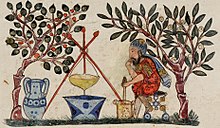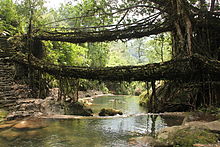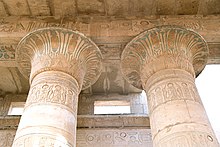Human uses of plants

Human uses of plants include both practical uses, such as for food, clothing, and medicine, and symbolic uses, such as in art, mythology and literature. Materials derived from plants are collectively called plant products.
Edible plants have long been a source of nutrition for humans, and the reliable provision of food through agriculture and horticulture is the basis of civilization since the Neolithic Revolution. Medicinal herbs were and still remain to be the key ingredients of many traditional medicine practices, as well as being raw materials for some modern pharmaceuticals. The study of plant uses by native peoples is ethnobotany, while economic botany focuses on modern cultivated plants. Plants are also used as feedstock for many industrial products including timber, paper and textiles, as well as a wide range of chemicals.
Ornamental plants give millions of people pleasure through gardening, and floriculture is a popular pastime among many. Viticulture and winemaking can provide both culinary and economic values to society. In art, mythology, religion, literature and film, plants play important roles, symbolising themes such as fertility, growth, purity, and rebirth. In architecture and the decorative arts, plants provide many themes, such as Islamic arabesques and the acanthus forms carved on to classical Corinthian order column capitals.
Context
[edit]Culture consists of the social behaviour and norms found in human societies and transmitted through social learning. Cultural universals in all human societies include expressive forms like art, music, dance, ritual, religion, and technologies like tool usage, cooking, shelter, and clothing. The concept of material culture covers physical expressions such as technology, architecture and art, whereas immaterial culture includes principles of social organization, mythology, philosophy, literature, and science.[1] This article describes the many roles played by plants in human culture.[2]
Practical uses
[edit]As food
[edit]
Humans depend on plants for food, either directly or as feed for domestic animals. Agriculture deals with the production of food crops, and has played a key role in the history of world civilizations. Agriculture includes agronomy for arable crops, horticulture for vegetables and fruit, and forestry for timber.[3] About 7,000 species of plant have been used for food, though most of today's food is derived from only 30 species. The major staples include cereals such as rice and wheat, starchy roots and tubers such as cassava and potato, and legumes such as peas and beans. Vegetable oils such as olive oil provide lipids, while fruit and vegetables contribute vitamins and minerals to the diet.[4]
In industry
[edit]
Plants grown as industrial crops are the source of a wide range of products used in manufacturing, sometimes so intensively as to risk harm to the environment.[5] Nonfood products include essential oils, natural dyes, pigments, waxes, resins, tannins, alkaloids, amber and cork. Products derived from plants include soaps, shampoos, perfumes, cosmetics, paint, varnish, turpentine, rubber, latex, lubricants, linoleum, plastics, inks, and gums. Renewable fuels from plants include firewood, peat and other biofuels.[6][7] The fossil fuels coal, petroleum and natural gas are derived from the remains of aquatic organisms including phytoplankton in geological time.[8]
Structural materials and fibres from plants are used to construct dwellings and to manufacture clothing. Wood is used not only for buildings, boats, and furniture, but also for smaller items such as musical instruments, hand tools, and sports equipment. Wood is pulped to make paper and cardboard.[9] Cloth is often made from cotton, flax, ramie or synthetic fibres such as rayon and acetate derived from plant cellulose. Thread used to sew cloth likewise comes in large part from cotton.[10]

Plants are a primary source of basic chemicals, both for their medicinal and physiological effects, and for the industrial synthesis of a vast array of organic chemicals.[11]
In medicine
[edit]Many hundreds of medicines are derived from plants, both traditional medicines used in herbalism[12][13] and chemical substances purified from plants or first identified in them, sometimes by ethnobotanical search, and then synthesised for use in modern medicine. Modern medicines derived from plants include aspirin, taxol, morphine, quinine, reserpine, colchicine, digitalis and vincristine. Plants used in herbalism include ginkgo, echinacea, feverfew, and Saint John's wort. The pharmacopoeia of Dioscorides, De Materia Medica, describing some 600 medicinal plants, was written between 50 and 70 AD and remained in use in Europe and the Middle East until around 1600 AD; it was the precursor of all modern pharmacopoeias.[14][15][16]
For chemicals
[edit]Pesticides derived from plants include nicotine, rotenone, strychnine and pyrethrins.[17] Plants such as tobacco, cannabis, opium poppy, and coca yield psychotropic chemicals.[18] Poisons from plants include atropine, ricin, hemlock and curare, though many of these also have medicinal uses.[19]
In gardening
[edit]
Thousands of plant species are cultivated for aesthetic purposes as well as to provide shade, modify temperatures, reduce wind, abate noise, provide privacy, and prevent soil erosion. Plants are the basis of a multibillion-dollar per year tourism industry, which includes travel to historic gardens, national parks, rainforests, forests with colorful autumn leaves, and festivals such as Japan's[20] and America's cherry blossom festivals.[21]
There are also art forms specializing in the arrangement of cut or living plants, such as bonsai, ikebana, and the arrangement of cut or dried flowers. Ornamental plants have sometimes changed the course of history, as in tulipomania.[22]
In science
[edit]
Basic biological research has often been done with plants. In genetics, the breeding of pea plants allowed Gregor Mendel to derive the basic laws governing inheritance,[23] and examination of chromosomes in maize allowed Barbara McClintock to demonstrate their connection to inherited traits.[24] The plant Arabidopsis thaliana is used in laboratories as a model organism to understand how genes control the growth and development of plant structures.[25] NASA predicts that space stations or space colonies will one day rely on plants for life support.[26]
Scientific advances in genetic engineering led to developments in crops. Genetically modified crops introduce new traits to plants which they do not have naturally. These can bring benefits such as a decrease in the use of harmful pesticides, by building in qualities such as insect resistance and herbicide tolerance.[27]
Living structures
[edit]
The ability of trees to graft is occasionally exploited by tree shaping to create living root bridges in Meghalaya and Nagaland states in India and on the islands of Sumatra and Java in Indonesia. The aerial roots of rubber fig trees, Ficus elastica, are used to form suspension bridges across mountain streams.[28][29][30][31][32]
Symbolic uses
[edit]In art
[edit]
Plants appear in art, either to illustrate their botanical appearance,[33] or for the purposes of the artist, which may include decoration or symbolism, often religious. For example, the Virgin Mary was compared by the Venerable Bede to a lily, the white petals denoting purity of body, while the yellow anthers signified the radiant light of the soul; accordingly, European portraits of the Virgin's Annunciation may depict a vase of white lilies in her room to indicate her attributes. Plants are also often used as backgrounds or features in portraits, and as main subjects in still lifes.[34][35]

Architectural designs resembling plants appear in the capitals of Ancient Egyptian columns, which were carved to resemble either the Egyptian white lotus or the papyrus.[36] Ancient Greek columns of the Corinthian order are decorated with acanthus leaves.[37] Islamic art, too, makes frequent use of plant motifs and patterns, including on column capitals. These designs became increasingly elaborate and stylised, appearing as complex arabesque and geometric motifs in objects such as the Ardabil Carpet and ten-pointed Persian ceramic star tiles, influencing the decorative arts in the Western world in such forms as the Rococo and later the Arts and Crafts movement.[38][39][40]
In literature and film
[edit]
Both real and fictitious plants play a wide variety of roles in literature and film.[41] Plants' roles may be evil, as with the triffids, carnivorous plants with a whip-like poisonous sting as well as mobility provided by three foot-like appendages, from John Wyndham's 1951 science fiction novel The Day of the Triffids, and subsequent films and radio plays.[42] J. R. R. Tolkien's Middle-earth makes use of many named kinds of plant, including the healing herb athelas[43] the yellow star-flower elanor which grows in special places such as Cerin Amroth in Lothlórien,[44] and the tall mallorn tree[45] of the elves. Tolkien names several individual trees of significance in the narrative, including the Party Tree in the Shire with its happy associations,[45] and the malevolent Old Man Willow[46] in the Old Forest.[47] Trees feature in many of Ursula K. Le Guin's books, including the forest world of Athshe and the Immanent Grove[48] on Roke in the Earthsea series, to such an extent that in her introduction to her collection The Wind's Twelve Quarters, she admits to "a certain obsession with trees" and describes herself as "the most arboreal science fiction writer".[49] James Cameron's 2009 film Avatar features a giant tree named Hometree, the sacred gathering place of the humanoid Na'vi tribe; the interconnected tree, tribe and planet are threatened by mining: the tribe and the film's hero fight to save them.[50] Trees are common subjects in poetry, including Joyce Kilmer's 1913 lyric poem named "Trees".[51][52] Flowers, similarly, are the subjects of many poems by poets such as William Blake, Robert Frost, and Rabindranath Tagore.[53]
In mythology and religion
[edit]
Plants figure prominently in mythology and religion, where they symbolise themes such as fertility, growth, immortality and rebirth, and may be more or less magical.[54][55] Thus in Latvian mythology, Austras koks is a tree which grows from the start of the Sun's daily journey across the sky.[56][57] A different cosmic tree is Yggdrasil, the World tree of Norse mythology, on which Odin hung.[58][59] Different again is the barnacle tree, believed in the Middle Ages to have barnacles that opened to reveal geese,[60] a story which may perhaps have started from an observation of goose barnacles growing on driftwood.[61] Greek mythology mentions many plants and flowers,[62] where for example the lotus tree bears a fruit that causes a pleasant drowsiness,[63] while moly is a magic herb mentioned by Homer in the Odyssey with a black root and white blossoms.[64]
The mandrake is hallucinogenic and its roots can resemble a human figure, so it has long been used in magic, and is still used in contemporary paganism such as Wicca and Odinism.[65] Tabernanthe iboga is used as a hallucinogenic in Gabon by secret societies for initiation ceremonies.[66] Magic plants are found, too, in Serbian mythology, where the raskovnik is supposed to be able to open any lock.[67][68][69] In Buddhist symbolism, both the lotus and the Bodhi Tree are significant. The lotus is one of the Ashtamangala (eight auspicious signs) shared between Buddhism, Jainism and Hinduism, representing the primordial purity of body, speech, and mind, floating above the muddy waters of attachment and desire.[70] The Bodhi Tree is the sacred fig tree under which the Buddha is said to have attained enlightenment; the name is also given to other Bodhi trees thought to have been propagated from the original tree.[71]
See also
[edit]References
[edit]- ^ Macionis, John J.; Gerber, Linda Marie (2011). Sociology. Pearson Prentice Hall. p. 53. ISBN 978-0137001613. OCLC 652430995.
- ^ Shoemaker, Candice A. (1994-08-02). "Plants and Human Culture". Journal of Home & Consumer Horticulture. 1 (2–3): 3–7. doi:10.1300/j280v01n02_02.
- ^ "The Development of Agriculture". National Geographic. 2016. Retrieved 20 June 2016.
- ^ "Food and drink". Kew Gardens. Archived from the original on 28 March 2014. Retrieved 1 October 2017.
- ^ "Industrial Crop Production". Grace Communications Foundation. 2016. Retrieved 20 June 2016.
- ^ "INDUSTRIAL CROPS AND PRODUCTS An International Journal". Elsevier. Retrieved 20 June 2016.
- ^ Cruz, Von Mark V.; Dierig, David A. (2014). Industrial Crops: Breeding for BioEnergy and Bioproducts. Springer. pp. 9 and passim. ISBN 978-1-4939-1447-0.
- ^ Sato, Motoaki (1990). Thermochemistry of the formation of fossil fuels (PDF). The Geochemical Society.
{{cite book}}:|work=ignored (help) - ^ Sixta, Herbert, ed. (2006). Handbook of pulp. Vol. 1. Winheim, Germany: Wiley-VCH. p. 9. ISBN 978-3-527-30997-9.
- ^ "Natural fibres". Discover Natural Fibres. Archived from the original on 15 May 2019. Retrieved 20 June 2016.
- ^ "Chemicals from Plants". Cambridge University Botanic Garden. Archived from the original on 9 December 2017. Retrieved 20 June 2016. Note that the details of each plant and the chemicals it yields are described in the linked subpages.
- ^ Tapsell LC, Hemphill I, Cobiac L, et al. (August 2006). "Health benefits of herbs and spices: the past, the present, the future". Med. J. Aust. 185 (4 Suppl): S4–24. doi:10.5694/j.1326-5377.2006.tb00548.x. hdl:2440/22802. PMID 17022438. S2CID 9769230.
- ^ Lai PK, Roy J; Roy (June 2004). "Antimicrobial and chemopreventive properties of herbs and spices". Curr. Med. Chem. 11 (11): 1451–60. doi:10.2174/0929867043365107. PMID 15180577.
- ^ "Greek Medicine". National Institutes of Health, USA. 16 September 2002. Retrieved 22 May 2014.
- ^ Hefferon, Kathleen (2012). Let Thy Food Be Thy Medicine. Oxford University Press. p. 46. ISBN 9780199873982.
- ^ Rooney, Anne (2009). The Story of Medicine. Arcturus Publishing. p. 143. ISBN 9781848580398.
- ^ Duke, S.O. (1990). Janick, J.; Simon, J.E. (eds.). "Natural pesticides from plants". Advances in New Crops: 511–517.
- ^ "Psychoactive Substances: A Guide to Ethnobotanical Plants and Herbs, Synthetic Chemicals, Compounds and Products" (PDF). Health Service Executive, Ireland. Retrieved 20 June 2016.
- ^ Long, Scott. "Natural Products -- Plants". South West Oklahoma State University. Archived from the original on 28 February 2014. Retrieved 20 June 2016.
- ^ Sosnoski, Daniel (1996). Introduction to Japanese culture. Tuttle. p. 12. ISBN 978-0-8048-2056-1.
hanami
- ^ "History of the Cherry Blossom Trees and Festival". National Cherry Blossom Festival: About. National Cherry Blossom Festival. Archived from the original on 14 March 2016. Retrieved 22 March 2016.
- ^ Lambert, Tim (2014). "A Brief History of Gardening". British Broadcasting Corporation. Retrieved 21 June 2016.
- ^ Blumberg, Roger B. "Mendel's Paper in English".
- ^ "BARBARA McCLINTOCK:A Brief Biographical Sketch". WebCite. Archived from the original on 27 September 2011. Retrieved 21 June 2016.
- ^ "About Arabidopsis". TAIR. Retrieved 21 June 2016.
- ^ "Engineering Life". NASA. Archived from the original on 2 April 2010. Retrieved 21 June 2016.
- ^ Wolfenbarger, L. L.; Phifer, P. R. (2000-12-15). "The Ecological Risks and Benefits of Genetically Engineered Plants". Science. 290 (5499): 2088–2093. Bibcode:2000Sci...290.2088W. doi:10.1126/science.290.5499.2088. PMID 11118136. S2CID 2094394.
- ^ Lewin, Brent (November 2012). "India's living Bridges". Reader's Digest Australia. pp. 82–89. Archived from the original on 16 November 2012.
- ^ "Living Root Bridge in Laitkynsew India". www.india9.com. Retrieved 22 February 2010.
- ^ "Living Root Bridges of Nagaland India – Nyahnyu Village Mon District | Guy Shachar". guyshachar.com. 16 April 2016. Retrieved 7 September 2017.
- ^ "Baduy Tribe". Ruby Mangunsong. 13 December 2015. Retrieved 7 September 2017.
- ^ Grundhauser, Eric. "West Sumatra, Indonesia Jembatan Akar". Atlasobscura.
- ^ Antheunisse, Max (2009). "About". Plant Illustrations. Retrieved 20 June 2016.
- ^ "Botanical Imagery in European Painting". Metropolitan Museum of Art. Retrieved 19 June 2016.
- ^ Raymond, Francine (12 March 2013). "Why botanical art is still blooming today". The Daily Telegraph. Retrieved 19 June 2016.
- ^ Wilkinson, Richard H. (2000). The Complete Temples of Ancient Egypt. Thames and Hudson. pp. 65–66. ISBN 978-0-500-05100-9.
- ^ Lewis, Philippa; Darley, Gillian (1986). Dictionary of Ornament. New York: Pantheon. p. not cited. ISBN 9780394509310.
- ^ "Plant motifs in Islamic art". Victoria and Albert Museum. 2011-03-31. Retrieved 19 June 2016.
- ^ Macarthur, John (2013). The Picturesque: Architecture, Disgust and Other Irregularities. Routledge. p. 6. ISBN 978-1-134-95697-5.
- ^ Kirkham, Pat; Weber, Susan (2013). History of Design: Decorative Arts and Material Culture, 1400?2000. Yale University Press. pp. 201–. ISBN 978-0-300-19614-6.
- ^ "Literary Plants". Nature Plants. 1 (11): 15181. 2015. doi:10.1038/nplants.2015.181. PMID 27251545.
- ^ "Top 10: evil plants from films". The Daily Telegraph. Retrieved 19 June 2016.[dead link]
- ^ The Fellowship of the Ring, I 12 "Flight to the Ford".
- ^ The Fellowship of the Ring, II 6 "Lothlórien".
- ^ a b The Return of the King, VI 9 "The Grey Havens".
- ^ The Fellowship of the Ring, I 6 "The Old Forest".
- ^ Hazell, Dinah (2007). The Plants of Middle-Earth: Botany and Sub-Creation. Kent State University Press. ISBN 978-0-87338-883-2.
- ^ Le Guin, Ursula K. (2001). Tales from Earthsea. Harcourt. p. 59. ISBN 978-0-15-100561-1.
- ^ Freedman, Carl Howard (2008). Conversations with Ursula K. Le Guin. University Press of Mississippi. pp. 12–13. ISBN 978-1-60473-094-4.
- ^ Cameron, James. "Avatar" (PDF). Avatar Screenings. Fox and its Related Entities. p. 25. Archived from the original (PDF) on 25 May 2010. Retrieved 9 February 2010.
- ^ "Poetry". Spirit of Trees. Retrieved 21 June 2016.
- ^ "Tree Poems". Poem Hunter. Retrieved 21 June 2016.
- ^ "Flower Poems". Poem Hunter. Retrieved 21 June 2016.
- ^ "Plants in Mythology". Myth Encyclopedia. Retrieved 20 June 2016.
- ^ Leitten, Rebecca Rose. "Plant Myths and Legends". Cornell University Liberty Hyde Bailey Conservatory. Retrieved 20 June 2016.
- ^ Ķencis, Toms (2011). "The Latvian Mythological space in scholarly Time" (PDF). Archaeologia Baltica. 15 (15): 144–157. doi:10.15181/ab.v15i1.28. Archived from the original (PDF) on 25 March 2012. Retrieved 21 August 2012.
- ^ Vīķe-Freiberga, Vaira (2005). "Saule". In Jones, Lindsay (ed.). Encyclopedia of Religion. Vol. 12 (2nd ed.). Thomson Gale. pp. 8131–8135.
- ^ [[Ursula Dronke|Dronke, Ursula (Trans.)]] (1997). The Poetic Edda: Volume II: Mythological Poems. Oxford University Press. p. 7. ISBN 978-0-19-811181-8.
- ^ Davidson, Hilda Ellis (1993). The Lost Beliefs of Northern Europe. Routledge. p. 69. ISBN 978-0-203-40850-6.
- ^ "Barnacle Goose". The Medieval Bestiary. Retrieved 20 June 2016.
- ^ Beatrice White (1945). "Whale-hunting, the barnacle goose, and the date of the "Ancrene Riwle". Three notes on Old and Middle English". The Modern Language Review. 40 (3): 205–207. doi:10.2307/3716844. JSTOR 3716844.
- ^ "Flora 1: Plants of Greek Myth". Theoi. Retrieved 20 June 2016.
- ^ Brewer, Ebenezer Cobham. Lotus tree. p. 526.
{{cite book}}:|work=ignored (help) - ^ Chisholm, Hugh, ed. (1911). "Moly". Encyclopædia Britannica. Vol. 18 (11th ed.). Cambridge University Press. p. 681. cites: Homer, Odyssey, x. 302–306.
- ^ John Gerard (1597). "Herball, Generall Historie of Plants". Claude Moore Health Sciences Library. Archived from the original on 2012-09-01. Retrieved 2016-09-26.
- ^ Pope, Harrison G. (1969-04-01). "Tabernanthe iboga: an African narcotic plant of social importance". Economic Botany. 23 (2): 174–184. doi:10.1007/BF02860623. ISSN 0013-0001. S2CID 34302143.
- ^ Стойнев, Анани; Димитър Попов; Маргарита Василева; Рачко Попов (2006). "Костенурка". Българска митология. Енциклопедичен речник (in Bulgarian). изд. Захари Стоянов. p. 165. ISBN 978-954-739-682-1.
- ^ Старева, Лилия (2007). Български магии и гадания (in Bulgarian). Труд. pp. 243–244. ISBN 978-954-528-772-5.
- ^ Раденковић, Љубинко (2000–2001). Расковник у кругу сличних биљака (in Serbian). Slavic Gate. Archived from the original on 25 June 2010. Retrieved 24 August 2010.
- ^ Anderson, E.N.; Pearsall, Deborah; Hunn, Eugene; Turner, Nancy (2012). Ethnobiology. John Wiley & Sons. p. 602. ISBN 978-1-118-01586-5.
- ^ Gethin, Rupert (1998). The Foundations of Buddhism. Oxford University Press. p. 22. ISBN 978-0-19-289223-2.
